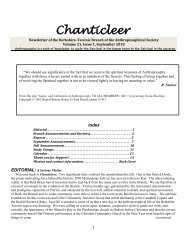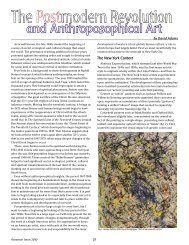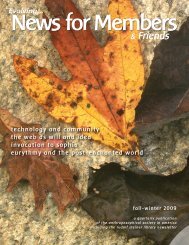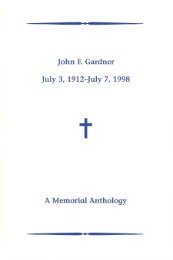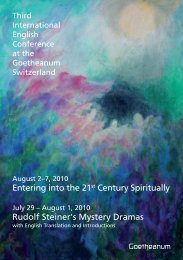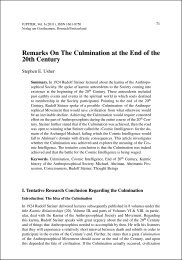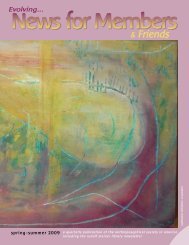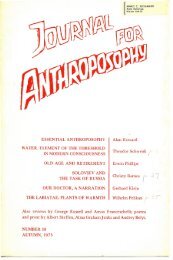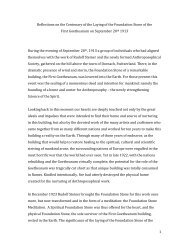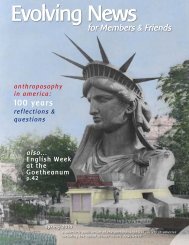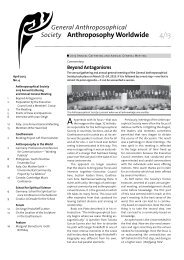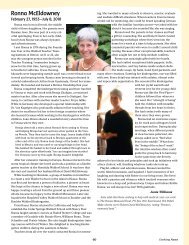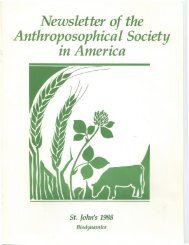Rudolf Steiner's Vision for the Future - Anthroposophical Society in ...
Rudolf Steiner's Vision for the Future - Anthroposophical Society in ...
Rudolf Steiner's Vision for the Future - Anthroposophical Society in ...
You also want an ePaper? Increase the reach of your titles
YUMPU automatically turns print PDFs into web optimized ePapers that Google loves.
Keep<strong>in</strong>g Faith with <strong>the</strong> Human Be<strong>in</strong>g<br />
Greet<strong>in</strong>gs and welcome! With this issue we are evolv<strong>in</strong>g<br />
<strong>the</strong> “News <strong>for</strong> Members” of <strong>the</strong> <strong>Anthroposophical</strong> <strong>Society</strong><br />
<strong>in</strong>to a publication which we are call<strong>in</strong>g simply be<strong>in</strong>g<br />
human. We’ve talked about this step <strong>for</strong> two years, and are<br />
tak<strong>in</strong>g it <strong>in</strong> time <strong>for</strong> <strong>Rudolf</strong> Ste<strong>in</strong>er’s 150th anniversary year,<br />
which also beg<strong>in</strong>s a second century of anthroposophical<br />
collaborations <strong>in</strong> North America.<br />
We are also mak<strong>in</strong>g this issue much more widely available,<br />
so we extend a welcome to new friends. be<strong>in</strong>g human<br />
could not be a more <strong>in</strong>clusive title, and we mean <strong>for</strong> it to<br />
po<strong>in</strong>t to that balanc<strong>in</strong>g act, of self-development both alone<br />
and <strong>in</strong> relationships, which we all share <strong>in</strong>. To be human is<br />
to be <strong>in</strong>complete, unf<strong>in</strong>ished, <strong>in</strong> progress. Messy, troubled,<br />
despair-mak<strong>in</strong>g; and <strong>the</strong>n wondrous, hopeful, uplift<strong>in</strong>g.<br />
Between downdrafts and giddy exaltations we make our way<br />
<strong>for</strong>ward.<br />
“Keep<strong>in</strong>g faith?” Through much of <strong>the</strong> last fifty years <strong>the</strong><br />
thought has been present “<strong>in</strong> <strong>the</strong> culture” that <strong>the</strong> human<br />
race is not a good th<strong>in</strong>g. “We’re prone to violence and cruelty<br />
and this beautiful Earth would fare better without us.” Such<br />
was <strong>the</strong> voice of our collective “dark night of <strong>the</strong> soul.”<br />
Be<strong>in</strong>g human isn’t easy, and we need <strong>the</strong> sober encouragement<br />
of serious people. If our actions are not what <strong>the</strong>y<br />
should be, still it is we ourselves who know that, and it is we<br />
who can change <strong>the</strong>m. Already <strong>in</strong> his first foundational book,<br />
The Philosophy of Freedom, <strong>the</strong> young <strong>Rudolf</strong> Ste<strong>in</strong>er was<br />
look<strong>in</strong>g <strong>in</strong>cisively at <strong>the</strong> condition of <strong>the</strong> human be<strong>in</strong>g: “We<br />
have torn <strong>in</strong>to two what is really an <strong>in</strong>separable whole: <strong>the</strong><br />
human be<strong>in</strong>g. We have dist<strong>in</strong>guished between <strong>the</strong> knower<br />
and <strong>the</strong> doer and have left out of account precisely <strong>the</strong> one<br />
who matters most of all: <strong>the</strong> know<strong>in</strong>g doer.”<br />
That book was a key research <strong>in</strong>to overcom<strong>in</strong>g <strong>the</strong><br />
apparent limits of human consciousness. And he went on to<br />
identify <strong>the</strong> key challenge, <strong>in</strong> How to Know Higher Worlds:<br />
“Unless we learn to develop with<strong>in</strong> ourselves <strong>the</strong> deeply<br />
From <strong>the</strong> Editor<br />
rooted feel<strong>in</strong>g that <strong>the</strong>re is someth<strong>in</strong>g higher than ourselves,<br />
we shall not f<strong>in</strong>d <strong>the</strong> strength to evolve to someth<strong>in</strong>g higher.”<br />
This very gifted man was an heir to <strong>the</strong> great culture of<br />
Europe. He watched a thousand years of its culture wrecked<br />
<strong>in</strong> “<strong>the</strong> Great War,” but he spent his days and years research<strong>in</strong>g<br />
<strong>the</strong> human condition and our potential <strong>for</strong> fur<strong>the</strong>r<br />
evolution. He came to see <strong>the</strong> human be<strong>in</strong>g quite objectively<br />
not as a cosmic accident but as a cosmic participant on a<br />
vast scale. And he became a master of practical action, help<strong>in</strong>g<br />
plant seed after seed of a healthier culture, a new global<br />
civilization worthy of <strong>the</strong> best <strong>in</strong> us. He kept faith with <strong>the</strong><br />
human be<strong>in</strong>g, both <strong>the</strong> ideals of our conscience and <strong>the</strong><br />
reality of our needs and shortcom<strong>in</strong>gs. And because <strong>Rudolf</strong><br />
Ste<strong>in</strong>er knew our capacity to grow, he was a mentor and<br />
advisor on self-development, but not a guru substitut<strong>in</strong>g his<br />
will <strong>for</strong> that of his admirers. And so he provided a great and<br />
liv<strong>in</strong>g map to <strong>the</strong> human future, both <strong>in</strong>timate and vast,<br />
which he called anthroposophy, “<strong>the</strong> consciousness of our<br />
humanity.”<br />
In this issue<br />
Our lead article by Prof. Frederick Amr<strong>in</strong>e on page 7 is<br />
a scholar’s thoughtful <strong>in</strong>troduction to <strong>Rudolf</strong> Ste<strong>in</strong>er presented<br />
as a challenge to his colleagues to discover a genius, a<br />
real giant <strong>in</strong> <strong>the</strong> <strong>in</strong>tellectual and cultural history of our times.<br />
Admittedly, Ste<strong>in</strong>er did not focus on be<strong>in</strong>g available to <strong>the</strong><br />
academic world, but acted as someth<strong>in</strong>g more like a great cultural<br />
gardener. On page 68 we <strong>in</strong>clude a full lecture from<br />
1909 which displays his reach, approach, and cont<strong>in</strong>u<strong>in</strong>g<br />
relevance: “From Creature to Creator: The Human Be<strong>in</strong>g and<br />
Our <strong>Future</strong> Evolution.” Add<strong>in</strong>g his research <strong>in</strong> consciousness,<br />
<strong>in</strong> “spirit,” to natural scientific concepts of evolution, he<br />
makes <strong>the</strong> fur<strong>the</strong>r observation, both subtle and profound,<br />
that evolution specific to human be<strong>in</strong>gs proceeds by “creation<br />
out of noth<strong>in</strong>gness.” It takes artistic and ethical perception,<br />
as well as scientific, to reach such an <strong>in</strong>sight.<br />
be<strong>in</strong>g human is a quarterly publication of <strong>the</strong> <strong>Anthroposophical</strong> <strong>Society</strong> <strong>in</strong> America, 1923 Geddes Avenue, Ann Arbor, MI 48104<br />
View it onl<strong>in</strong>e at www.anthroposophy.org — to advertise call Cynthia Chelius at 734-662-9355 — or email editor@anthroposophy.org.<br />
first issue 2011 • 1



